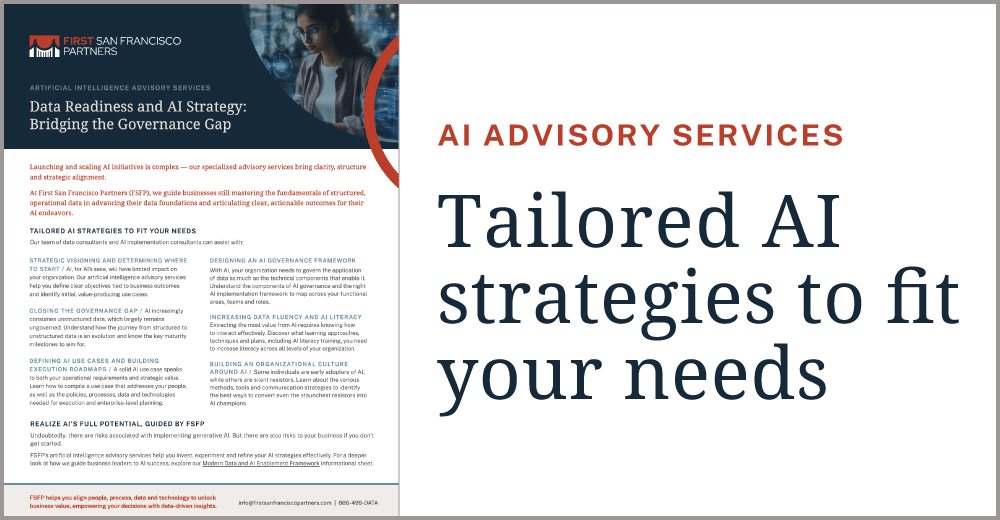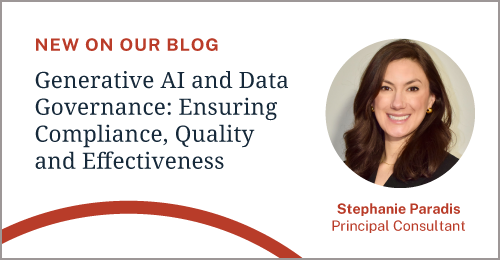Generative AI (genAI) is opening new frontiers in creativity, automation and innovation, pushing the boundaries of what technology and humans can achieve together. Enthusiasm for genAI started high, but a lack of tangible results, operational efficiencies and strong return on investments has slightly cooled sentiments.
That’s because genAI is not a silver bullet. Successful integration of genAI isn’t just chasing down and implementing the latest technology or tool; it demands a strategic and phased approach.
While genAI may be one of our most advanced technologies, it’s also the next step on a continuous spectrum of innovation we’re all familiar with. GenAI doesn’t reinvent the wheel; it just requires some tailoring to its unique properties.
What GenAI Can Do for Your Organization
GenAI can potentially add value across all business functions by spurring innovation through productivity. At its core, genAI is an analytic tool meant to mimic human cognitive function in the creation of new material. It automates the creation process for us — freeing up time to spend on more strategic, complex or innovative activities.
Given the breadth of opportunities for use, it can be challenging to know where to start with genAI — and it can be helpful to start by looking at broader use case categories and narrowing down from there:
- ADMINISTRATION: Creating materials whose purpose/function is to keep your organization, team or individual progressing forward.
Examples: drafting memos, creating itineraries or plans, scheduling - SUMMARIZATION: Articulating key facts, themes or ideas in a body of work.
Examples: summarizing complex legal documents, distilling insights from lengthy market research reports, identifying trends and patterns within a data set - DECISION SUPPORT: Collecting, analyzing and presenting information and actionable insights to help users make decisions, answer questions or take action. (It’s not so much about what genAI does as how it’s used.)
Examples: compiling a list of FAQs from submitted inquiries, delivering real-time recommendations from dynamic data sets, tailoring an AI agent or chatbot for domain-specific use
- CREATIVE ASSISTANCE: Generating creative outputs that provide value through innovation, enhancement or new capabilities. (By far, this is the most wide-ranging category.)
Examples: These produced artifacts fall into one of three categories: 1) a piece of work intended to stand on its own — e.g., article, painting, translated communication piece; 2) a piece of work that becomes an input to a larger process — e.g., design mockup, marketing strategy; or 3) an artifact/tool you did not have before that allows you to unlock new levels of work — e.g., synthetic data sets allowing new or advanced/expanded analysis. - CODING AND AUTOMATION: Simplifying the development and execution of technical solutions, automating workflows and improving system interoperability.
Examples: Writing software code, creating APIs, automating data labeling or generating scripts for repetitive tasks.
Simply adding AI to existing workflows won’t create sustainable competitive advantages.
Why GenAI Alone Won’t Guarantee Success
Despite the hype, genAI is not a silver bullet. Simply adding AI to existing workflows won’t create sustainable competitive advantages.
Real value emerges when you:
- Reimagine processes: Integrate AI into the core of business strategies rather than using it as an add-on.
- Focus on goals: Ensure AI initiatives align with your company’s value proposition and objectives.
- Implement thoughtfully: Take a phased, methodical approach to build capabilities and scale effectively.
Four-Phase Approach to GenAI Adoption
To set yourself up for success with GenAI acceptance, follow a structured roadmap.
PHASE 0: SET THE FOUNDATION
So much of what is required for an organization’s application of AI and its appropriate governance is only uncovered by “doing” AI. So, avoid boiling the ocean.
Before launching any AI initiative, establish the baseline requirements for governance and build the technical and organizational infrastructure needed to support it; this foundation includes:
- Technical readiness: Secure your cloud resources, APIs and data pipelines to deploy AI models.
- Data and AI governance: Establish appropriate data access controls, enforce minimum data quality standards, and implement an initial risk management framework.
Organizational alignment: Educate your stakeholders and set clear expectations about what genAI can and cannot do.
(You might be wondering why we start at Phase 0 — it’s to emphasize that you shouldn’t be in this phase for too long. Laying the governed groundwork is critical, but don’t overengineer it from the start. Not only will you lose people in complexity and delay, but so much of what needs to be brought into your governance framework can only be discovered by doing AI.)
PHASE 1: ACTIVATE AI
Begin with a pilot project that balances exploratory goals with tangible value. Select a use case that demonstrates measurable impact while providing insights for future initiatives. The initial use case should be well-scoped and attainable within a reasonable timeline. It’s also critical to pick a use case from which subsequent, value-producing efforts can be spun off — avoid building in silos.
Examples include:
- Creating a domain-specific assistant
- Summarizing large datasets for reporting and decision-making.
- Assisting with policy to code translation and code validation against policies
PHASE 2: SCALE AI
Build on the success of your initial efforts by applying genAI in focused areas where it can make a cumulative impact, then expand that success to other parts of your organization. Focus on growing in two key ways:
- Go deeper: Reimagine entire processes through the cumulative productivity gains of integrating genAI into its supporting tasks.
- Go broader: A shared core of processes, data and technology underpins rapid deployment. Look to expand into adjacent business domains where you can leverage what you’ve already built.
PHASE 3: REVOLUTIONIZE THE BUSINESS
AI has the power to reshape how your organization operates. Rather than simply reacting to emerging technologies, this phase encourages you to rethink your strategies, ensuring your business remains focused and strategically grounded amidst recurring disruption.
By carefully integrating AI into your business approach, you can discover fresh opportunities, stay adaptable in dynamic markets and maintain a competitive edge. It’s a matter of resilience, positioning your organization to navigate challenges with agility and foresight.
Critical Role of Data Governance for AI
There’s widespread recognition that even the most perfect model will underperform without the right data. AI will not automatically identify and resolve the underlying data issues as part of its use case application. Dedicated efforts are required before data ingestion, mainly because genAI relies heavily on the messages, themes and ideas embedded within the data.
To build systems that deliver impactful, reliable and fit-for-purpose outcomes, focus on uniting three governance disciplines under a single vision.
- Data governance: Governance establishes the people, policies and processes needed to ensure data remains secure, compliant and fit for purpose. Its scope encompasses structured, semi-structured and unstructured data, bringing new paradigms for existing data management capabilities like metadata management and data quality. The cross-functional decision-making frameworks that data governance introduces serve as the backbone for critical AI visibility and decision-making.
- Information and content management: A hallmark of genAI is how well-suited it is for unstructured data in content or documentation. Governance ensures that appropriate mechanisms are in place to manage access to sensitive documentation and to identify quality content that suits the business purpose. This is where those new metadata and data quality paradigms are brought in — and how do we measure the quality of unstructured data? Through the quality of its metadata.
- AI governance: If we think of AI as the application of data, AI governance is the natural extension of data governance. This means it needs to build from the data governance framework to consider how data is consumed, processed, used and stored in relation to AI use cases. The core components of data governance still apply, but they are administered on the collective AI system (technology, model, data, use case) rather than exclusively the model or the data.
Data governance is the framework that unites stakeholders’ roles and facilitates transparency of AI efforts.
Integrating Data Governance Into AI Efforts
To build a culture of governance around AI, your organization needs to:
- Embed governance from the beginning: Start with building the minimum required governance infrastructure while you’re getting your technologies stood up. There needs to be a multilateral commitment to not building without guidance — but don’t let governance overengineering stifle innovation.
- Intentionally design cross-functional collaboration: Successful AI is a team effort. At every step in the AI lifecycle, there is a seat at the table for the different perspectives needed to drive effective and ethical decision-making — governance, IT/digital, legal, security, privacy/compliance and the business units.
- Keep humans in the loop: At key decision points in the AI development process, there are ideal opportunities for human-based controls. Assemble cross-functional teams, led by risk management, to review and approve progression to the next phase. Further, be sure to define user requirements for AI solutions — how are they expected to validate inputs and outputs before use?
When getting started with building an AI capability, visibility and communication are among the most important components to prioritize. Each stakeholder represents a different function — and different focuses and responsibilities. Data governance is the framework that unites the roles and facilitates transparency of AI efforts.
FSFP’s data consulting experts are ready to partner with you in developing and implementing tailored governance strategies that support your AI initiatives.
Pair AI With Data Governance, Supported by FSFP
GenAI has the power to revolutionize industries, bringing innovation through productivity. To harness its full potential at your organization, however, align AI initiatives with business goals, implement strong governance and prioritize quality data. Your success lies in starting with clear, strategic use cases and scaling thoughtfully to balance opportunity with risk. By embedding responsible practices into every step, you can unlock meaningful benefits in leveraging AI for lasting impact.
At FSFP, we understand the nuances of implementing genAI and the critical role governance plays in navigating data complexities. Our data consulting experts are ready to partner with you in developing and implementing tailored governance strategies that support your AI initiatives — genAI, agentic AI, AI data literacy etc. — and drive tangible business value. Let us know how we can help you.



